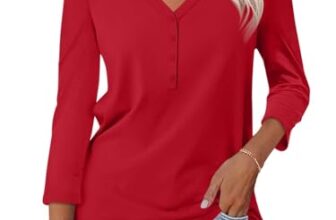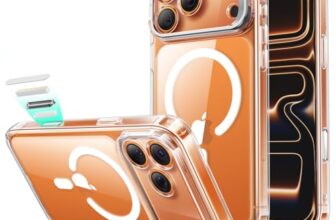A Technical Examination of the Protective Storage Case for the JBL PartyBox 520
The acquisition of a high-output portable audio system, such as the JBL PartyBox 520, represents a significant capital investment in acoustic technology. These systems are engineered for robust performance, yet their material composition—comprising polymers, sensitive electronic components, and finely-tuned speaker cones—remains inherently vulnerable to environmental and mechanical stressors. The primary engineering challenge in protecting such a device is twofold: providing comprehensive shielding against particulate ingress, moisture, and impact forces, while simultaneously ensuring that the protective solution does not impede the device’s operational functionality or portability. This review presents a deep technical analysis of a purpose-built speaker case designed for the JBL PartyBox 520. We will deconstruct its material composition, evaluate its design from an ergonomic and functional standpoint, and benchmark its protective capabilities against the known risks of mobile deployment. The objective is to provide a data-driven assessment for owners and operators, determining if this accessory meets the rigorous demands of safeguarding a high-value asset in dynamic environments.
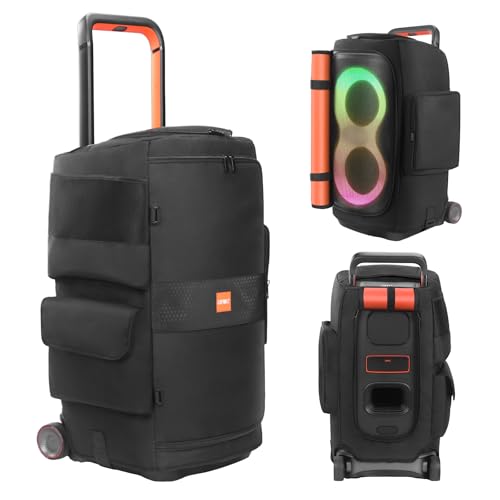
Comprehensive Feature Analysis and Material Deconstruction
A thorough evaluation of this protective case requires a granular examination of its core design features and the scientific principles underpinning its material selection. Each component is assessed for its intended function and its contribution to the overall system efficacy.
1. Compatibility and Fitment Tolerances
The fundamental prerequisite of any effective protective enclosure is precision fitment. The specified internal dimensions of this case are 28.7" H x 15.9" L x 12.2" W. These figures correspond closely to the nominal dimensions of the JBL PartyBox 520, suggesting a design engineered for minimal internal displacement. A snug fit is critical for two primary reasons: first, it minimizes the potential for the speaker to shift during transit, which could cause abrasive wear on the speaker’s housing; second, it ensures that the case’s structural load-bearing points align correctly with the speaker’s chassis, distributing weight and impact forces as intended. The design incorporates a bottom-mounted Velcro fixing strap. From a mechanical engineering perspective, this is a crucial feature. This hook-and-loop fastener system serves as a vertical stabilizer. During transport, especially over uneven terrain, vertical oscillations can cause a “jumping” effect within a loose-fitting bag. This strap effectively couples the speaker’s base to the case, mitigating this risk and preventing the speaker from riding up and potentially exposing its lower portion or stressing the upper seams of the case. The choice of industrial-grade Velcro, with its high shear strength, ensures a secure bond that resists the dynamic forces encountered during movement, while its peel strength allows for easy removal by the user.
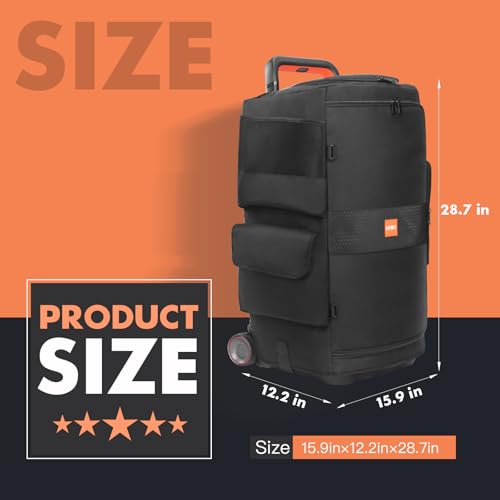
2. Multi-Window Zipper System and Operational Accessibility
A major design challenge for a “play-through” case is providing access to controls and ports without compromising protection. This case employs a sophisticated system of zippered openings and roll-up panels to achieve this objective. The design can be analyzed in three distinct zones:
- Main Panel Access: The front and rear panels utilize a “roller blind” design. This consists of large flaps that can be unzipped along their perimeter and rolled upwards, where they are secured by integrated Velcro tabs. This provides unobstructed access to the speaker grille on the front and the main I/O panel on the rear (including AC power, USB port, and Mic/Guitar inputs). This design is ergonomically superior to fully removable panels, which can be misplaced, or simple flaps, which may not stay open reliably.
- Top Control Panel Access: The top control surface of the PartyBox 520 is arguably the most frequently accessed area. The case addresses this with a dedicated, separate zipper opening. The use of a zipper here, likely a durable nylon coil type, is a deliberate choice. It creates a seal against dust, debris, and light moisture when closed—a level of protection a simple magnetic or Velcro flap would not provide. This allows the operator to make on-the-fly adjustments to volume, lighting, and playback without removing or fully opening the main case body.
- Acoustic Transparency: The manufacturer claims the case can be used without affecting sound quality. This hinges on the acoustic properties of the front roller blind panel material. For minimal sound degradation, this fabric must have low acoustic impedance. This is typically achieved using a woven, porous material that allows air—the medium of sound waves—to pass through with minimal reflection or absorption. High-frequency sounds, having shorter wavelengths, are most susceptible to being muffled by physical barriers. The efficacy of this design would depend on the fabric’s thread count and weave density. A properly engineered acoustic mesh would allow the PartyBox 520’s tweeters and woofers to perform without significant dampening, preserving the speaker’s intended frequency response.

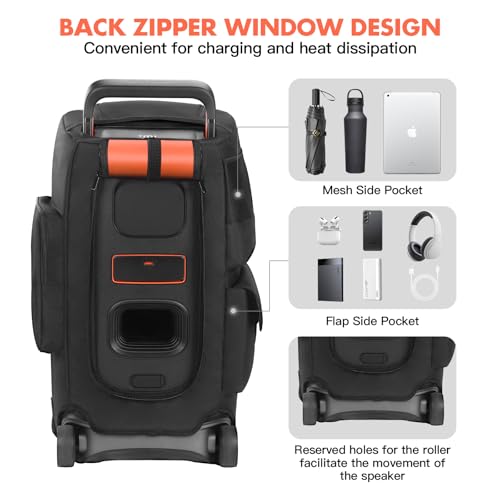
3. Multifunctional Pockets and Accessory Management
A significant value proposition of this case is its integrated storage system, which transforms it from a simple dust cover into a comprehensive gear transport solution. The case features multiple external pockets, each designed with specific accessories in mind. A technical breakdown reveals a highly organized system:
- High-Volume Pockets: Larger pockets are designed to accommodate items like tablets, folded umbrellas, or water bottles. These are likely constructed with gussets to allow for expansion.
- Dedicated Microphone Storage: The design explicitly mentions storage for up to four microphones. For these pockets to be effective, they would require internal padding or elastic loops to secure the microphones, preventing them from colliding with each other and protecting their sensitive capsules from shock.
- Cable and Charger Management: Smaller, zippered pockets are ideal for organizing power cables, audio cables (XLR, 1/4″), and chargers. This segregation prevents “cable spaghetti” and allows for rapid deployment and pack-up, a critical efficiency factor for mobile professionals.
- Personal Item Pockets: Additional pouches provide convenient storage for smaller items like mobile phones, keys, and wallets. The strategic placement of these pockets on the exterior ensures that all necessary accessories for a performance or event can be co-located with the speaker, creating a self-contained, grab-and-go package. This level of organization is not a trivial feature; it is a direct contributor to workflow efficiency and reduces the risk of leaving critical components behind.
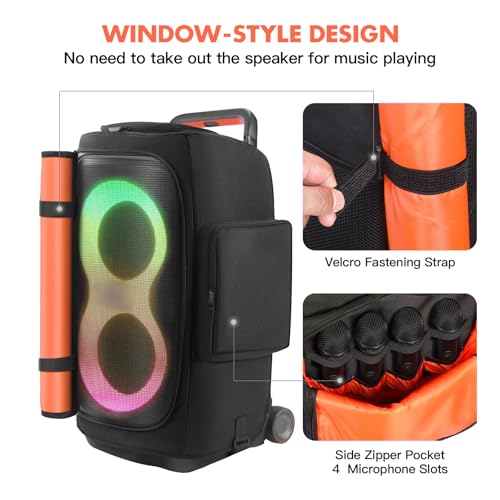
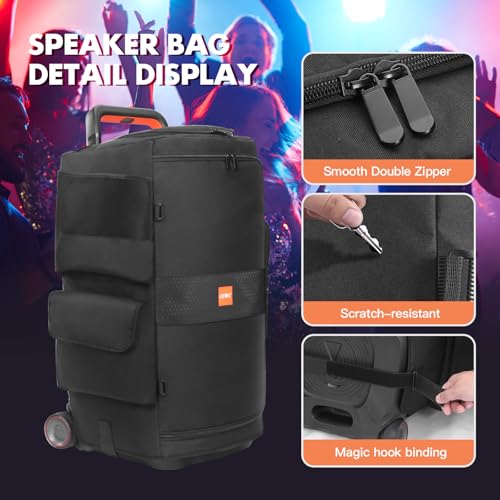
4. Material Science of the Tri-Laminate Structure
The protective capability of the case is derived from its three-layer composite construction. Each layer serves a distinct physical purpose:
- Outer Layer (Tear-Resistant Polyester): Polyester is selected for its high tensile strength and excellent abrasion resistance. Its synthetic polymer fibers are resistant to stretching and shrinking. Furthermore, polyester is hydrophobic, meaning it repels water. While not fully waterproof (seams are a point of potential ingress), this layer provides crucial protection against spills, light rain, and moisture. The tear-resistant quality implies a high-denier weave, which increases the material’s durability against snags and punctures encountered during transport.
- Interlayer (PE Cotton): This is the core protective layer. “PE cotton” refers to polyethylene foam padding. This closed-cell foam is lightweight and has excellent shock-absorption properties. When an impact force is applied to the case, the foam compresses, dissipating the energy over a larger area and a longer period, thus reducing the peak force transmitted to the speaker chassis. Its closed-cell nature also makes it highly resistant to water absorption, preventing the case from becoming waterlogged and adding a secondary layer of moisture protection. The thickness of this PE foam layer is the primary determinant of the case’s overall impact resistance rating.
- Inner Lining (Soft Velvet): The innermost layer’s function is to prevent cosmetic damage. The JBL PartyBox 520 has a textured polymer housing that can be susceptible to scuffs and scratches. Velvet, with its dense, short pile, provides a non-abrasive surface that cradles the speaker. This material effectively eliminates friction-based wear that could occur during transit from vibrations and shifting, preserving the speaker’s aesthetic condition and resale value.
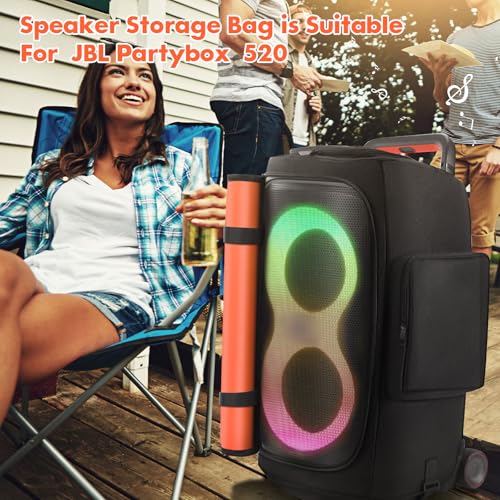

5. Portability and Ergonomic Design
Despite its robust construction, the case is described as lightweight. This is achieved through the use of modern materials like PE foam and polyester, which offer a high protection-to-weight ratio. The case’s handles and potential shoulder strap (if included) are critical ergonomic components. The handles must be made from reinforced webbing and attached to the main body with high-stress stitching (e.g., box or X-stitching) to handle the considerable weight of the PartyBox 520. Their placement is also vital for achieving a balanced carry, preventing user fatigue. An additional feature is its collapsibility. The case can be easily folded when not in use, which is a significant advantage for storage in a vehicle or a small studio where space is at a premium. The materials are chosen to resist permanent creasing, ensuring the case retains its structural form when redeployed.
Technical Pros: A Synthesis of Advantages
- Multi-Layered Protection System: The tri-laminate construction of polyester, PE foam, and velvet provides a comprehensive defense matrix. It systematically addresses abrasion, impact, and scratches, offering a higher degree of protection than a simple single-layer dust cover.
- High-Functionality “Play-Through” Design: The system of zippered openings and roll-up panels is intelligently engineered. It allows full operational access to all controls and I/O ports without needing to remove the speaker from the case, maximizing both protection and convenience during use.
- Integrated Logistics Solution: The extensive network of purpose-built storage pockets elevates the product from a simple case to a complete gear management system. This organizational capacity streamlines workflow for mobile professionals and enthusiasts alike.
- Precision Fitment and Stabilization: The case is dimensioned for a snug fit, and the inclusion of a bottom Velcro stabilizing strap is a key technical feature that prevents internal movement and ensures stability during transport.
Technical Cons: An Assessment of Limitations
- Water Resistance vs. Waterproofing: While the polyester outer shell is water-resistant, the use of zippers and stitched seams means the case is not fully waterproof. It will protect against light rain or spills but should not be considered submersible or suitable for prolonged exposure to heavy downpours.
- Acoustic Transparency Limitations: While designed for play-through use, any fabric placed in front of a speaker grille will introduce some level of acoustic attenuation, however minor. Critical listening applications may still necessitate rolling up the front panel for perfect audio fidelity, especially in the highest frequencies.
- Thermal Dissipation Concerns: The JBL PartyBox 520, like any high-power amplifier, generates heat during operation. The multi-layered, padded design of the case will inherently act as an insulator. During extended use at high volumes, especially in warm environments, heat buildup could be a concern. Users should monitor the speaker’s temperature when operating it within the closed case for long durations.
Conclusion: Final Engineering Assessment
In conclusion, this speaker case for the JBL PartyBox 520 is a well-engineered accessory that demonstrates a clear understanding of the user’s needs for protection, portability, and operational accessibility. Its multi-laminate material construction provides a robust defense against common transport-related hazards. The design’s standout feature is its intelligent “play-through” capability, which allows the speaker to be used while remaining almost fully encased, offering a significant advantage over traditional transport bags.
The integrated storage system is not merely an add-on but a core feature that enhances the product’s value proposition by transforming it into a holistic logistics tool. While limitations regarding absolute waterproofing and potential thermal buildup exist, these are acceptable trade-offs for the level of convenience and protection offered. For any owner of a JBL PartyBox 520—be they a mobile DJ, an event organizer, or a serious enthusiast who frequently transports their equipment—this case represents a technically sound and highly functional investment for safeguarding their audio asset. It successfully balances robust protection with practical usability, making it a top-tier recommendation for 2025.
See more posts in the category Speaker.





